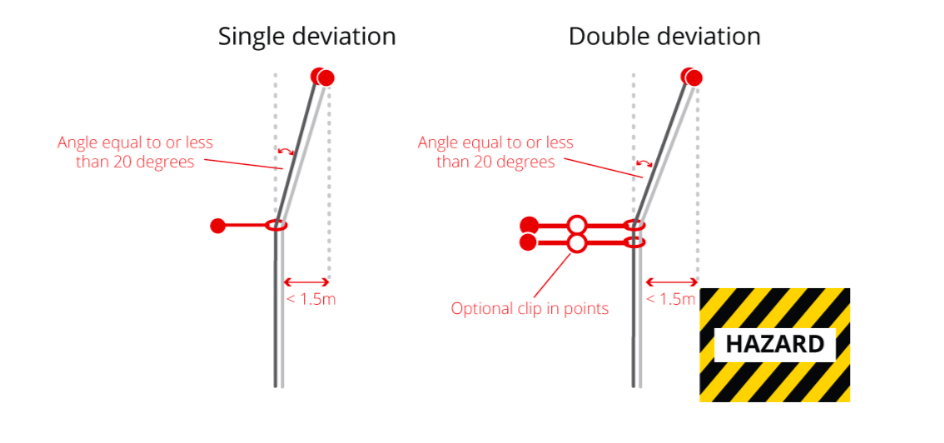Understanding the IRATA Syllabus: Rigging Deviations
Deviations allow you to redirect the path of the ropes for accurate positioning, or to avoid hazards. Different from a re-anchor, a deviation can be rigged for rescue, assuming that the suspended worker is below said deviation point.
A series of deviation anchors can also provide lateral restraint during a long descent, protecting the tech from being moved around by the wind –ensuring that your position is always controlled.
There are two types of deviations:
Single Anchor Deviation
This deviation changes the direction of the ropes (or working line alone) by a small angle of, generally, less than 20 degrees. The single deviation is rigged with a single-anchor system; you would only use this deviation if the failure of that single anchor would not result in an out-of-control swing causing damage to the working lines or the technician.

Double Anchor Deviation
New guidance from IRATA provided in Doc. No.: GU235ENG stipulates that a double anchor deviation that a technician would have to pass should generally have the same offset of 20 degrees or less. The difference, then, would be the presence of a hazard. If there is a risk of an out-of-control swing, and that swing could cause the technician or rope system to come into contact with the structure and/or a sharp edge or other serious hazard, this is the deviation you’d use.
Another application for a double deviation could be in roof or platform rigging, in which case the technician would not be responsible for passing the deviation, and the angle could be more than a 20 degree offset; keeping in mind that the critical angle of a deviation is 60 degrees.
During your IRATA Assessment, L2 and L3 certifying techs will be asked to demonstrate competence rigging either one of these deviations, while thinking about repositioning ease of use. How easy is it to pass the deviation while ascending or descending? To answer this question, look at the angle of the deviation, and its distance from the anchor point, or from another deviation on the rope system.
If you’re a certifying L2 tech, you will be asked to demonstrate competence rigging a specific deviation.
If you’re a certifying L3 tech, you will be given a hypothetical situation, and will demonstrate competence by choosing, and then rigging, the appropriate deviation for that situation.
There isn’t just one way to rig a deviation – IRATA assessors recognize a variety of different methods as being acceptable (which we’ll cover during training).
Please note: Re-anchors and deviations both work by redirecting the path of the ropes, but there are situations where one is more appropriate than the other. For example, if you’re working with a particularly wide angle, you may want to rig a re-anchor instead of a deviation.
We’ll go into further detail on how to identify which strategy is more appropriate for a given situation during your training week, along with how to protect against anchor loading, and how to identify the required anchor strength in relation to the angle of deflection.
Additional resources to check out:
TACS 6.4.8 for the source material for this blog.
TACS 9.6.3-9.6.4 for a full list of major and minor discrepancies.
--
This is part of an ongoing series, where we’re breaking down IRATA’s syllabus and clarifying exactly what ‘demonstrating competence’ and ‘demonstrating awareness’ means, and what will be expected of you on assessment day. As an IRATA L2 certifying tech, you’re expected to be fully competent with the L1 Syllabus. To return back to the IRATA L2 Study Guide or IRATA L3 Study Guide, click below:

